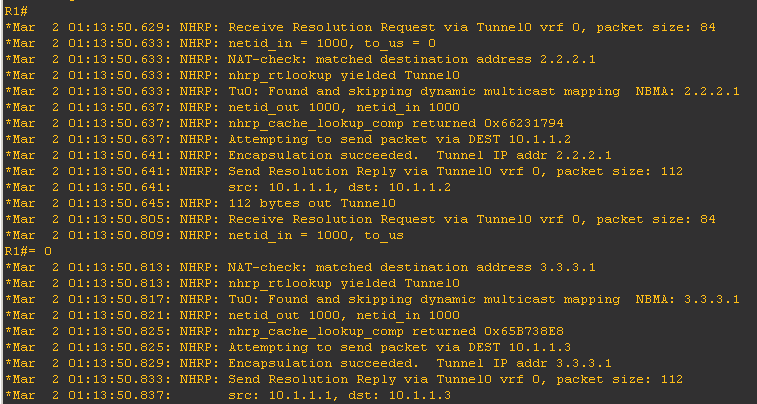Continuing from the previous post, let's now see how phase 2 works.
The major difference between phase 1 and phase 2 is that in phase 2, the spokes can communicate to other spokes directly by using the NHRP mapping information from the hub.
To enable the spoke to create dynamic tunnels, we will remove the tunnel destination command and change the tunnel mode to "gre multipoint".
At the moment, we can see that R2 is learning the loopback of R3 with the next hop 10.1.1.1 (hub's tunnel IP).
We will have to get this changed so R1 preserves the next-hop value when it sends the update to the spoke routers.
If we check R2's routing table now, We can see that the next-hop points to R3's tunnel interface.
Let's test reachability of 192.168.3.1 from R2 with the source being local loopback0.
We can see that the traffic from R2 to R3 doesn't traverse through R1. There is an NHRP entry for R3 on R2.
From where did R2 receive the information about R3's NBMA address ?
When R2 tried to ping R3's loopback, it queried R1 to provide information about R3's public IP address.
Upon receiving the request, R1 checked it's own NHRP table and replied back with R3's NBMA IP address. It also informed R3 about the NBMA adresss of R2.
Once the spokes received the information, they started communicating directly.
We will look at Phase 3 in the next post.
The major difference between phase 1 and phase 2 is that in phase 2, the spokes can communicate to other spokes directly by using the NHRP mapping information from the hub.
To enable the spoke to create dynamic tunnels, we will remove the tunnel destination command and change the tunnel mode to "gre multipoint".
At the moment, we can see that R2 is learning the loopback of R3 with the next hop 10.1.1.1 (hub's tunnel IP).
We will have to get this changed so R1 preserves the next-hop value when it sends the update to the spoke routers.
If we check R2's routing table now, We can see that the next-hop points to R3's tunnel interface.
Let's test reachability of 192.168.3.1 from R2 with the source being local loopback0.
From where did R2 receive the information about R3's NBMA address ?
When R2 tried to ping R3's loopback, it queried R1 to provide information about R3's public IP address.
Upon receiving the request, R1 checked it's own NHRP table and replied back with R3's NBMA IP address. It also informed R3 about the NBMA adresss of R2.
Once the spokes received the information, they started communicating directly.
We will look at Phase 3 in the next post.










No comments:
Post a Comment